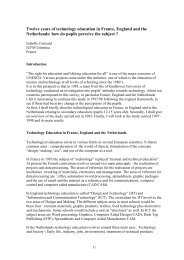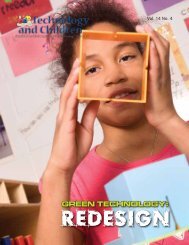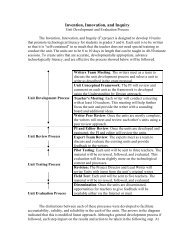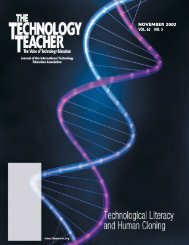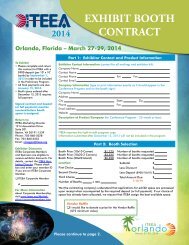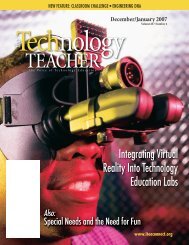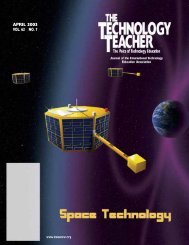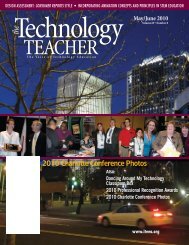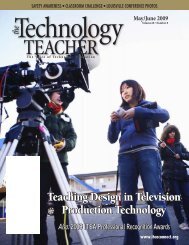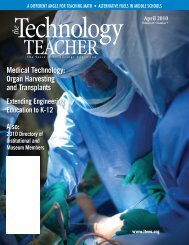October 2004 - Vol 64, No.2 - International Technology and ...
October 2004 - Vol 64, No.2 - International Technology and ...
October 2004 - Vol 64, No.2 - International Technology and ...
- No tags were found...
You also want an ePaper? Increase the reach of your titles
YUMPU automatically turns print PDFs into web optimized ePapers that Google loves.
When each team had its car runningthe best, a run was made so that thescience teacher could record the besttime. Students wanted their team’scar to be the fastest. The students hadto use the information gained <strong>and</strong>calculate the speed of their best run.FEATURE ARTICLEA student cuts her car to shape.ideas to paper. These designs were tobe used in their technology educationclasses to develop full-size workingdrawings. It was during this stagethat it was determined that the kit’swooden piece would not lend itself toeasily changing wheels <strong>and</strong> testingdifferent lubricants. A new design wasused, with a hole drilled through thewood for a steel rod axle. This wouldmean the kit could no longer be used,<strong>and</strong> wood would need to be cut forthe cars. It also meant axles <strong>and</strong>wheels needed to be purchased.Car wooden bodies were cut out of2 x 4s <strong>and</strong> given to each team. Whenthey had their working drawings completed,they copied their shapes onthe wooden bodies. After receivinginstruction on machines <strong>and</strong> passingrelevant safety quizzes, students werepermitted to cut out the shapes. Thecar bodies were then finish-s<strong>and</strong>ed toa smooth finish.Wheels were attached, <strong>and</strong> the studentsmade sure their cars would godown the ramp in a straight path. Thiswas a very good time to watch thestudents as they reacted. Some carshad problems that needed some problemsolving. Teams were first to makecorrections. If this could not be done,it was suggested that they work withanother team for a solution. Theteacher was the last contact for thesolution. From a teaching point ofview, it was fantastic the way studentshelped each other. The teachersuggested that students should usethe concept of helping others in reallife.Some students, who had completedtheir projects ahead of schedule,applied paint to their cars. Many hadto do some problem solving to seewhy the wheels would not turn aseasily after the painting. It wasnow time for the cars to go to thescience room.The cars were weighed <strong>and</strong> theinformation recorded. Studentsrecorded the car’s time for goingdown the technology education ramp.Students could add weight (washersattached with a stickpin) <strong>and</strong> test tosee if it improved the car’s speed.They applied the weight all over thecar <strong>and</strong> had a lot of fun in the process.The data for this was also recorded.When the team arrived at its besttime, the students kept their car inthat configuration.The teacher recorded each car’s speedbefore any testing or changes, as areference point to plot its progress.Students were given a chance to usegraphite, lithium grease, or siliconlubricant to make the cars run faster.Again the data was recorded.After all the information was collected,the students went to the computerroom <strong>and</strong> designed a Web page todisplay their findings. A digitalpicture was taken of the team<strong>and</strong> uploaded to the site along withthe information gained.Another interdisciplinary activity usedwas the designing of a Rube Goldbergdevice. The students were to make adevice at home <strong>and</strong> display it atschool. The students were havingproblems with making a drawing ofthe device, so the technology educationteacher helped in the process. Amath teacher suggested that the technologyeducation department continueto have students learn aboutmeasuring, as it helps the studentsimprove that skill. For more activities,go to the “Members Only” area onthe ITEA Web site <strong>and</strong> locate theIdeaGarden Archives.When developing items that areinterdisciplinary, care must be takento ensure that the activities alignwith the st<strong>and</strong>ards of all the disciplinesinvolved.The science teacher said, “One ofthe biggest successes of this projectwas the level of excitement. I do notremember when I last had studentsthis excited about a project. Studentswere talking about their cars, comparingresults, bragging about howwell they did, etc. It was verygratifying to see them so excited. Idon’t know how much knowledgetransfer has taken place but, if nothingelse, we excited them about science<strong>and</strong> technology.”One of the items in the discussionstage was to share our ideas. Theresult is this article. In the future,26 <strong>October</strong> <strong>2004</strong> • THE TECHNOLOGY TEACHER



